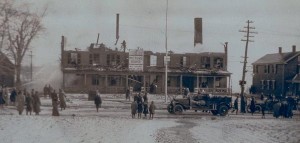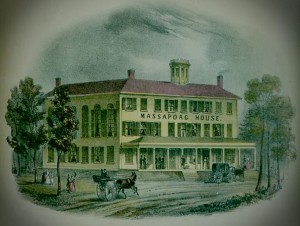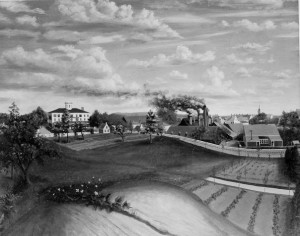True Tales from Canton’s Past: Massapoag House
By George T. ComeauOur kitchen is the “Canton room,” according to my wife. Of course, all things Canton seem to find their way into every room of our house. As part of her spring-cleaning ritual, several pieces of framed artwork have found their way onto the kitchen walls, pieces that might have been relegated to an upstairs closet. One of my favorite bits of Canton memorabilia is the sheet music cover for the Massapoag March. This once grand part of Canton’s history can now only be found in images and distant memories.
Today, as a new hotel goes up near the foot of the Great Blue Hill, it turns out that this is our first new hotel since the Massapoag House was built in 1789. And while there is a long history of taverns and boarding houses in Canton, indeed the Massapoag House was a true “hotel” by all standards.
The three-story Massapoag House was an imposing structure located on the land of the present-day post office. For over 70 years this landmark was the center of social and Catholic life in our community. It is hard to imagine such a grand building imposing upon the streetscape, but Massapoag House was quite a special place. At the Boston Museum of Fine Arts there is a painting in the Karolik Collection of American Paintings, and this 1850 landscape by an unknown artist (perhaps Joseph Hidley 1830-1872) shows an idyllic view of Canton and the Kinsley Iron Works, and most specially the Massapoag House.
The building began life in 1789 as a private residence for Jonathan “Quaker” Leonard. Quaker Leonard was, well, a Quaker — a member of the Society of Friends — and a businessman and partner of Adam Kinsley. And at age 26, Quaker Leonard was building considerable wealth. Leonard descended from a family that hailed from Pontypool, England, and when they came to America, they brought with them the knowledge of the working of iron ore.
Leonard’s father, Eliphalet, began making guns for the American Revolution in Easton, and it was here that Jonathan Leonard met Kinsley. Leonard, known to be eccentric and bright, obtained even more insight into iron production when, upon hearing that steel was being made in Pennsylvania, he traveled there to investigate. Under the guise of being a simpleton, he engaged in industrial espionage and worked as a menial employee at the furnace, thus bringing even more knowledge to the business in Canton and Easton.
As for the other half of the partnership, for folks who know their history, Kinsley is a name synonymous with iron in Norfolk County, and at the time in America. In 1788, Leonard and Kinsley erected a blacksmith’s shop near the present-day waterfall at “Forge” Pond. The business was brisk, and between 1790 and 1800, more than 200 mill-saws and 3,600 scythes were manufactured, all implements of a growing post-colonial economy.
At the time, the majority of iron ore came from Lake Massapoag in Sharon. This 353-acre spring-fed lake was drawn down to expose bog iron that would be refined in Canton and Easton. It is no wonder that Massapoag House would have such a strong connection to the great pond in Sharon, as the source of wealth was the raw material that would build a nation.
So, in 1789, Leonard built Massapoag House next to the factory — by all accounts a large and imposing two-story building. The firm of Leonard & Kinsley continued until 1821 when the partnership split, and Leonard took the land on the easterly side of Washington Street and Kinsley took the land on the westerly side. Eventually, the Kinsley Iron Works would own all of the land when Leonard’s fortunes turned bad. Leonard believed that a rich mine of lead ore would be found in Easton, and he exhausted his considerable fortunes in pursuit of this mine. Massapoag House was lost to his creditors sometime between 1833 and 1835. Leonard left, some say in shame, and according to Huntoon, moved to New Orleans. Recent sources seem to indicate that he died on October 25, 1839, in Biloxi, Mississippi. Massapoag House became a public house managed by David Spaulding.
By the time the Viaduct was being built in 1834, James Bent was running his tavern at the site, and he ran a stagecoach line from Canton to Boston. Bent was the son of Captain William Bent, the landlord of the Eagle Inn. So in keeping with the family business, Massapoag House continued to be a tavern. A stop in Canton would have been on the route to Providence or Boston, and the stage line would have several places to drop passengers. The building was remade as a public house and the Canton Lyceum (a literary society) met regularly at this tavern. In fact, the Canton Lyceum was the “salon” of Canton — where ideas were debated regularly and eventually the literary collection would become the foundation of the Canton Public Library. The big change for Massapoag House would come in 1848, when Lyman Kinsley, Adam Kinsley’s son, expanded, remodeled and added a third-story, thus creating the finest rural hotel in New England.
The drawing in my kitchen is featured on the opening playbill for the Grand Ball, held on Thursday, February 3, 1848. It was Kinsley that gave the house its name, Massapaog House. There is another painting of this place. A beautiful landscape at the MFA was probably commissioned at this time and features both Kinsley’s new building and his factory. The color version of the oil painting shows a beautiful blue sky with cotton candy clouds. It is doubtful that the area ever boasted a beautiful sky, since the factory was so close by. For many years the hotel flourished, but the smoke from the forges in the immediate vicinity would make a stay disagreeable. By 1909, the fortunes of the Kinsley Iron Works were dissolved, and once again creditors would step in and sell the property.
In 1909, the Catholic Church bought the building at auction. As such, in more modern times the association more closely recalled with this building is that of the Canton Catholic Club and Guild. The basement boasted three bowling alleys while a movie theatre showed silent films, and in the rear of the first floor there was a large billiards parlor. Canton’s Catholic population had swelled during the late part of the 19th century, and to help occupy the attention and time, the Catholic Club offered many diversions. This was the home to the Canton Royal Rooters of 1915.

The fire that destroyed the Canton Catholic Club, 1918, photo by Judge Gregory Grover. (Courtesy of the Canton Historical Society)
The end would come more than 129 years after it was built. Early on January 5, 1918, fire destroyed the 130-year-old structure. “It was an absolutely fascinating thing to watch,” recalled Town Clerk Carlton Taber, who as a young boy remembered being at the scene after hearing the fire alarm split the frigid morning air. “The water became ice in nothing flat.” Judge Gregory Grover took several photos from his front lawn where the fire was fought.
So, as you climb the stairs to the Post Office, it is hard to imagine that the center of social life in Canton was here on this site. If you pause for a moment, you might hear the laughter of children, or catch a whisper of lovers on a first date; the strains of music float through time from the dance hall where Nathaniel Bent would cut the “pigeon’s wing.” As Huntoon writes: “The happy nights passed in the old hall will linger in the memory till time with us shall be no more.”
Short URL: https://www.thecantoncitizen.com/?p=4511












